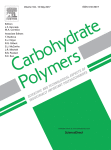Ver ítem
- xmlui.general.dspace_homeCentros e Institutos de InvestigaciónCIA. Centro de Investigaciones de AgroindustriaInstituto de Tecnología de AlimentosArtículos científicosxmlui.ArtifactBrowser.ItemViewer.trail
- Inicio
- Centros e Institutos de Investigación
- CIA. Centro de Investigaciones de Agroindustria
- Instituto de Tecnología de Alimentos
- Artículos científicos
- Ver ítem
Pectin-based composite film: effect of corn husk fiber concentration on their properties
Resumen
Considering the polysaccharide composition and 32% of crystallinity of the water insoluble fiber extracted from corn husk (CHF) agricultural residue, its filler performance as water vapor permeability (WVP) and mechanical modifier in edible films based on commercial low methoxyl pectin (LMP) was evaluated (0, 1, 3, 5, 8% concentrations). The 53-μm-CHF carried phenolics and carotenes, and composites showed antioxidant capacity. Homogeneous films with a
[ver mas...]
Considering the polysaccharide composition and 32% of crystallinity of the water insoluble fiber extracted from corn husk (CHF) agricultural residue, its filler performance as water vapor permeability (WVP) and mechanical modifier in edible films based on commercial low methoxyl pectin (LMP) was evaluated (0, 1, 3, 5, 8% concentrations). The 53-μm-CHF carried phenolics and carotenes, and composites showed antioxidant capacity. Homogeneous films with a continuous LMP matrix were obtained. The 5%-CHF composite showed the highest surface contact angle (44°) and tensile strength, without change in elongation, while WVP was decreased in the 3–8% CHF-LMP-films. The latter was ascribed to the CHF-filler crystallinity whereas the improvement in mechanical performance and contact angle was attributed to a CHF-interconnected network formed at 5%-CHF critical concentration. Corn husk residue can be utilized as a source of fibers for material development. Composites with enhanced performance can be an antioxidant strategy at food interfaces.
[Cerrar]

Autor
Bernhardt, Dana Cecilia;
Perez, Carolina Daiana;
Fissore, Eliana Noemi;
De'Nobili, Maria Dolores;
Rojas, Ana Maria Luisa;
Fuente
Carbohydrate Polymers 164 : 13-22 (May 2017)
Fecha
2017-05
ISSN
0144-8617
Formato
pdf
Tipo de documento
artículo
Palabras Claves
Derechos de acceso
Restringido
 Excepto donde se diga explicitamente, este item se publica bajo la siguiente descripción: Creative Commons Attribution-NonCommercial-ShareAlike 2.5 Unported (CC BY-NC-SA 2.5)
Excepto donde se diga explicitamente, este item se publica bajo la siguiente descripción: Creative Commons Attribution-NonCommercial-ShareAlike 2.5 Unported (CC BY-NC-SA 2.5)

